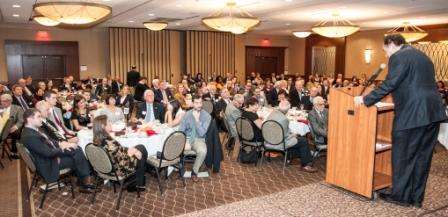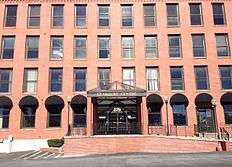Onondaga County Medical Society
| Formation | 1806 |
|---|---|
| Type | Professional Association |
| Headquarters | Syracuse, New York |
| Location | |
President | Richard Beers, MD |
| Mission | "...To promote and preserve quality health care by working for patients, physicians and the community." |
The Onondaga County Medical Society (OCMS) is a professional membership organization for physicians who live, or work, in Onondaga County, New York. As such, it is part of the larger network of medical organizations which includes the American Medical Association and the Medical Society of the State of New York.
According to its website, the mission of the OCMS is:
- "...To promote and preserve quality health care by working for patients, physicians and the community."[1]
The OCMS was founded in 1806 and has been in continuous operation since. It is operated and overseen by an Executive Council and maintains several standing committees with specific areas of interest, including membership, medical credentialing, public health, and workmen's compensation, and has an advisory committee for young practitioners.
History
.png)
On April 4, 1806, the New York State Senate and State Assembly passed “An Act to Incorporate Medical Societies for the purpose of regulating the practice of physic and surgery in this State.” The legislation, signed into law by Governor Morgan Lewis, permitted physicians to establish medical societies in their counties as a means of safeguarding medical practice and furthering public health. On July 1, of the same year, eleven physicians, including the first president of the society, Dr. John H. Frisbee, gathered at the Onondaga County Courthouse, on Onondaga Hill, to establish the Onondaga Medical Society. On that day, membership was open to any “doctor or surgeon” residing in the county, and an annual membership fee of 50¢ was set.
The early workings of the organization were heavily oriented towards improving the quality and availability of physicians within Onondaga County with public disclosure of who joined the society, where members resided, and how and why they came to live in the county. The organization maintained privacy for their monthly meetings, with minutes remaining confidential until 1830. Thereafter, records were made public. The organization remained structurally similar since its inception with a gradual lifting of membership restrictions on the basis of race, gender, and sexual orientation. At its inception the society had eleven members, by the end of its first year twenty two, and by its bicentennial, in July 2006, 1,262.
Executive Council
The Executive Council has historically been made of five officers and eight members at large as well as an OCMS President. Membership is limited to physicians and is selected by a combined volunteer and election process with specified term limits of between one and three years. The Executive Council meets privately once monthly at the OCMS headquarters, at the Learbury Centre, in Syracuse, New York. In addition to matters of public health, credentialing, academic interests, and fraternal matters the organizations finances are regulated by members of the Executive Council. Its annual budget for the organization has averaged two hundred and fifty thousand dollars.

The 2015-2016 Executive Council:
- Richard A. Beers, MD, President
- Dennis J. Nave, MD, Former President
- David R. Halleran, MD, Former President
- Michael G. Sheehan, MD, Treasurer
- Mary Abdulky, MD, Secretary
- Adam M. Bied, MD, Residency Representative
- Timothy M. Creamer, MD`
- Matthew G. Glidden, MD
- Barbara Krenzer, MD
- William Schreiber MD
- Sandra M. Sulik MD
- Darvin J. Varon, MD
Organization Activities

The OCMS hosts multiple events annually and has meetings once or more yearly with local politicians at the state and federal level, regional and nationally recognized physicians, medico-legal experts, and other individuals with relevance to the medical profession. Organization events are typically held at the Onondaga County Medical Society Headquarters located on North Salina street in, Syracuse, New York.
Prior speakers have included:
- Nationally recognized legal experts from the Kern Augustine Conroy & Schoppmann Law Firm.
- Senator John DeFransciso, New York State Senator, Representing the 50th District.
- William Magnarelli, Member of the New York State Assembly, Representing the 129th District.
- Senator David Valesky, New York State Senator, Representing the 53rd District.
- John Katko, United States Representative, New York's 24th Congressional District.
- Indu Gupta, MD, Commissioner of Health of Onondaga County.
- Robert Stoppacher, MD, The Chief Medical Examiner, Onondaga County Medical Examiners' Office.
Membership
The organization comprises over 1300 physician members representing multiple specialties and including individuals in residency training, private and hospital-based practice, academics, industry, as well as those in retirement. Membership is determined based on a combination of an application and review by the Executive Council. Dues are charged to member physicians on a yearly basis.